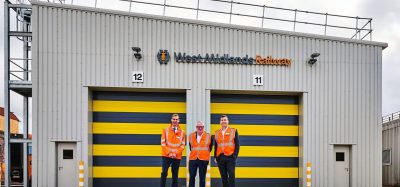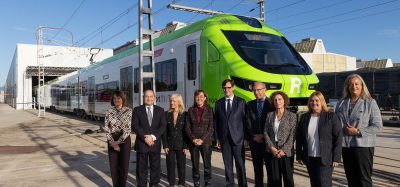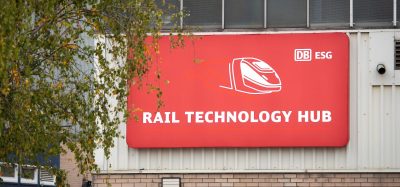An organised identity to focus on clear goals
Posted: 26 September 2007 | | No comments yet
Since last February, Banverket has taken on a new identity. The organisation is now totally focused on the customer: providing a higher level of reliability and punctuality and stopping the increasing costs for major investment projects. “If rail transport is to have a future, we must ensure the quality of today’s traffic. We must deliver the product expected by passengers and freight transporting operators. In addition, we must invest and develop the railway to respond to the demands of the future”, says Director General, Per-Olof Granbom.
Since last February, Banverket has taken on a new identity. The organisation is now totally focused on the customer: providing a higher level of reliability and punctuality and stopping the increasing costs for major investment projects. “If rail transport is to have a future, we must ensure the quality of today’s traffic. We must deliver the product expected by passengers and freight transporting operators. In addition, we must invest and develop the railway to respond to the demands of the future”, says Director General, Per-Olof Granbom.
Since last February, Banverket has taken on a new identity. The organisation is now totally focused on the customer: providing a higher level of reliability and punctuality and stopping the increasing costs for major investment projects.
“If rail transport is to have a future, we must ensure the quality of today’s traffic. We must deliver the product expected by passengers and freight transporting operators. In addition, we must invest and develop the railway to respond to the demands of the future”, says Director General, Per-Olof Granbom.
Since the founding of Banverket in 1988, it has been organised in five regions, all with independent planning, investments and activities. Now the organisation is divided into two divisions: Operations and Investment.
The Operations Division includes traffic management, maintenance, and customer contacts and is in charge of the everyday traffic and improving it. The Investment Division is a supervisory organisation for the major investment projects.
There are two main reasons why Banverket needed a change. Traffic growth has been massive in Sweden in recent years and the network has not been developed to the same extent, resulting in the traffic system around the three major cities, Stockholm, Göteborg, and Malmö being severely congested. Capacity is limited and punctuality rates have been poor. The second reason is a substantial increase in the costs of many large investments projects.
Other important factors are additional demands from external players and the public, such as an increased call for environmentally friendly transport modes. Rail is the safest and most environmentally friendly way of transporting both passengers and freight, and more people and companies are using Swedish railways.
But now we also need to adapt to new demands, in accordance with the EU-directive regarding liberalisation, competition and harmonisation.
In Sweden, competition on rail is a reality
The network of customers has changed radically from the single incumbent, SJ. Now there are 16 freight and transport companies and ten passenger operators. Of course, that requires a modern infrastructure manager who is easily available to the customer, especially in regard to discussing capacity allocation.
At the same time, the major investment projects all showed increasing costs. The overall costs in the construction sector had increased by 17% since 2004. A tighter control and coordinated follow-up on the budget and time schedule of all projects was requested by the politicians in the ministry of infrastructure.
All of the above led to the restructuring, Banverket now has a clear assignment from the management. The structure consists of three different roles: The expert, daily management of the traffic, including costumer contact, and professional supervision of investment projects: all of this from a national perspective – not primarily regional.
The Operations Division will, from a three-to-four year perspective, ensure the traffic contracted with the operators with high quality and punctuality. The division is responsible for the tracks, smaller adjustments for the benefit of the costumers on the line and terminals, maintenance, production plans, timetabling, traffic management and traffic information.
The Investment division is responsible for all major investments. It is a national division in charge of handling all investments in the same way, from planning to calculating, calls for tender, carrying out and finally putting the construction into business. Banverket will share best practices from one investment project to the next, using the same tools and calculations. We will be able to motivate and explain our decisions and priorities to the politicians in an early stage, to avoid surprises.
The restructuring does not mean that the ‘old’ organisation was wrong. It has done a great job from 1988 up through today. The employees have made huge efforts to handle the heavily increased traffic and many major investment projects are now underway.
The new organisation has had a kick start performing two important reports assigned by the government. We have made a half-time review of the long-term plan due to the same reasons as those behind the restructuring; major traffic growth, and heavily increased costs for investment projects. The government requires us to deliver a plan that is resilient. This revised plan forced some projects to be put on hold in favour of those that provide the most benefit to customers. The amended plan was submitted in June.
Some weeks later we also contributed with our report on the future direction of Swedish transport policy 2010-2019. We have described those efforts that need to be made within traffic, maintenance and investment up through 2019. The possibility for people to commute within larger areas, and public transport’s role in creating larger labour markets, is important for future planning. The railway and public transportation is also crucial for solving the congestion problem in urban areas. Together with the Road Administration, Banverket is also working on a joint program for public transportation including the important issue of accessibility for the disabled, etc.
It is a major challenge to maintain a high level of investment over several years.
Banverket also has to ensure that the strategic investment projects are carried out in a responsible way, both from a national public finance perspective and an environmental perspective. The construction of railways involves the entire process from preliminary studies to the opening of the new facilities for traffic. However, the long planning and implementation times for the new project is a dilemma. The infrastructure efforts must be based on visions of the future and sustainable implementation of those visions.
Train traffic helps us to limit carbon dioxide emissions, it helps us to save energy and reduce oil dependency, and it helps us to get closer to a zero-vision for accidental deaths in the transport sector. Well-functioning public transport on railways is a ‘must’ in order to meet the needs of the housing and labour markets, and through that, support regional development, employment and growth. But all this is dependent on high quality transport.
For example, a commuting parent has to be sure that he or she will get to work punctually and be able to get back home in time to pick up their children so that they can continue to football practice or some other activity. Industry’s rail transport of processed goods is always working against the clock and the goods have to arrive on time.
Banverket has formulated three areas where we have assessed that the railway transport system, in conjunction with other types of transport, can make major contributions to public development:
- Climate goals
- Regional development and growth
- Functions in major cities
There is a strong connection between regional expansion and the possibility to commute increasingly longer distances within large labour markets. At a distance of 100-150km, train traffic is often the only alternative for such a commute. Well-functioning regional train traffic provides increased freedom to choose a housing district in relation to the place where we work or study. The fact that this development has started shows that it is regional train traffic that increases. In many areas of the country, this traffic has doubled over the last decade. In some areas it increases annually by up to 15–20%.
To increase reliability and punctuality in the urban areas, projects have been started in Stockholm and Göteborg together with the operators to identify crucial and exposed areas in the system and how to strengthen them. A well functioning traffic is a result of a co-operation between the function of the infrastructure and the activities of the operators. It is all about design and maintenance of the infrastructure, operability of the engines and trains, and well thought-out time tables that are not too sensitive to instability. For Banverket, it is important to increase maintenance on the sensitive areas and invest to delete bottle-necks. We welcome these kind of joint solutions.
Attention is primarily given to the need for regional train traffic in major urban areas, but the railway also has great potential to bind population centres outside the urban areas together so that, as a network, they can function as larger and more richly varied labour market regions. Regional expansion, which leads to larger and more diversified labour markets, is considered by many to be a prerequisite for growth and competitiveness in a globalised market. Infrastructure investments, therefore, play an important role in achieving increased welfare for the country.
A well-functioning transport system is a prerequisite for the business sector’s competitiveness. The transport of goods by rail in Sweden is among the most efficient in Europe. Despite the fact that Sweden has substantially more beneficial regulations in regard to total weight and vehicle length for transport trucks, 25% of all long-distance goods in Sweden are transported by rail. The corresponding average for Europe is 15%.
The expansion of the railway that is now being carried out, or will have begun at the beginning of the planning period, is quite extensive. An increase in traffic can also be expected in the coming years. The expected increases – from already high levels – will affect the railway’s possibility to provide reliable and punctual transport. Therefore, Banverket believes that increased investments in quality should be a fundamental condition – not an alternative that can be dismissed.
The new Banverket organisation
The Director General’s Office employs approximately 35-40 people. It comprises the functions in supporting the Director General in directing the organisation and managing the corporate relations with the Swedish government, stakeholders and the public, etc.
The key functions are divided into Strategy and Marketing, Safety, Environment and Technology, Finance, International Affairs, Communications, Human Resources and Legal Matters.
Although divided into key functions, the Director General’s Office is small enough to work collaboratively and efficiently on the key issues. The overall objective is to co-ordinate across boundaries and simplify, thus delivering coherent and streamlined governance to the divisions and to the supporting units.
The Operations Division employs approximately 1,530 people. It delivers access to tracks to the operator including the entire chain from market contacts and planning to daily traffic management and maintenance. Five units in Malmö, Göteborg, Stockholm, Gävle and Luleå are in charge of traffic management and maintenance.
The Investment Division employs approximately 130 people. It is responsible for investigating, planning and building new railways on assignment from the GD-staff. Large projects are handled directly within the division. Smaller projects are handled by the division’s three regional project districts.
The Support Division employs approximately 1,000 people. Work is on an assignment and demand-governed basis within their competence areas: Analysis, Legal, Community Processes, HMSQ (Health, environment, safety, quality), Land and Property, Technology, Transport policy, Personnel, Information, Purchasing, Finance, Office services, Archives and journals, IT, FUD-co-ordination, Library, Swedish Railway Museum. The Support Division works at the national level and can assemble workers from many areas within the framework of a project or assignment.
About the author
A civil engineer at KTH (Royal Technical University), Per-Olof Granbom has worked in several high level positions in Banverket since its inauguration 1988, and was before that employed by the integrated SJ since 1964.
OUT NOW: The Definitive Guide to Rail’s Digital Future
The rail industry is undergoing a digital revolution, and you need to be ready. We have released our latest market report, “Track Insight: Digitalisation.”
This is not just another report; it’s your comprehensive guide to understanding and leveraging the profound technological shifts reshaping our industry. We move beyond the buzzwords to show you the tangible realities of AI, IoT, and advanced data analytics in rail.
Discover how to:
- Optimise operations and maintenance with real-time insights.
- Enhance passenger services through seamless, high-speed connectivity.
- Leverage technologies like LEO satellites to improve safety and efficiency.
Featuring expert analysis from leaders at Nomad Digital, Lucchini RS, Bentley Systems and more, this is a must-read for any rail professional.







